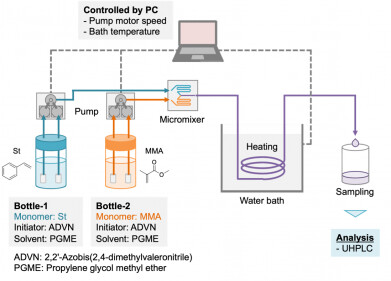-
 Experimental Image of a bee head captured with the quantum microscope without aberrations.
Experimental Image of a bee head captured with the quantum microscope without aberrations. -
 Experimental Image of a bee head captured with the quantum microscope in the presence of aberrations.
Experimental Image of a bee head captured with the quantum microscope in the presence of aberrations. -
 Experimental Image of a cat shaped object captured with the quantum microscope without aberrations
Experimental Image of a cat shaped object captured with the quantum microscope without aberrations -
 Experimental Image of a cat shaped object captured with the quantum microscope in the presence of aberrations
Experimental Image of a cat shaped object captured with the quantum microscope in the presence of aberrations
Research News
Quantum imaging brightens pathway for advanced microscopy
Mar 18 2024
Researchers from the UK and France have used the unique properties of quantum physics to enable microscopes to produce sharper images at the smallest scales.
Quantum enhanced microscopy makes the use of entangled photons in this new method of correcting for image distortion, offering potential for improved classical microscope imaging of tissue samples as well as advancements in other fields.
An invaluable tools for scientists for hundreds of years, advances in optics have enabled researchers to resolve ever-more detailed images of the fundamental structures of cells and materials.
As microscopes have developed in complexity, they have begun to run up against the limits of conventional optical technology, where even tiny flaws in the elements which resolve images can produce blurred images.
A process called adaptive optics is currently used to correct image distortions caused by aberrations, such as small imperfections in lenses and other optical components or by flaws in the sample under the microscope.
The key to adaptive optics is a ‘guide star’ - a bright spot identified in the sample under the microscope which provides a reference point for detecting aberrations. Devices called spatial light modulators can then shape the light and correct for these distortions.
Reliance on guide stars however, poses problems when the image samples, such as cells and tissues don’t contain bright spots. Scientists have developed guide star-free adaptive optics using image processing algorithms, but these can fail for samples with complex structures.
In their paper, the researchers describe how they used their new technique, referred to as quantum-assisted adaptive optics, to correct for distortion and retrieve high-resolution images of biological test samples – the mouthpiece and leg of a honeybee. They also demonstrate aberration correction for samples with three dimensional structures.
They used entangled photon pairs to illuminate the samples, allowing them to capture a conventional image and measure the quantum correlations at the same time.
When the entangled photon pairs encounter aberration, their entanglement - in the form of quantum correlations - becomes degraded. The information contained in the correlations allows for a precise characterisation of aberrations, enabling their correction with a spatial light modulator afterward. The paper shows that the correlations can be used to produce clearer, more high-resolution images than conventional brightfield microscopy techniques.
Patrick Cameron, of the University of Glasgow’s School of Physics & Astronomy, is the paper’s first author. He said: “Complex samples like biological tissues can be challenging to image using conventional approaches to microscopy, where the bright star technique can fail because there are rarely natural bright spots in human or animal tissue.
“This research shows that quantum-entangled sources of light can be used to probe samples in ways that are much more challenging, if not impossible, with traditional microscopy. Identifying and correcting aberrations and distortions with entangled photons allowed us to produce sharper images without the need for a guide star.”
Dr Hugo Defienne began work on the research at the University of Glasgow’s School of Physics & Astronomy before moving to the Paris Institute of Nanosciences at Sorbonne University, where he is now based. Dr Defienne, last author on the paper, said: “This new technique could be broadly applied to all kinds of conventional optical microscopes to help improve imaging of a wide range of samples. We demonstrated its effectiveness on biological samples, suggesting that it could be used in medical and biology sectors in the future.
“It could also be applied to the emerging field of quantum microscopy, which has tremendous potential to produce images beyond the limits of classical light.”
The team still have some technical hurdles to overcome before the technique can be widely adopted in optical microscopes.
Professor Daniele Faccio, who leads the University of Glasgow’s Extreme Light research group, is a co-author of the paper. He said: “The next generation of cameras and light sources are likely to help improve the speed which images can be resolved using this technique. We will continue to work on refining and developing the process and look forward to finding new real-world applications for advanced microscopy as we progress.”
Researchers from the University of Cambridge and the Laboratoire Kastler Brossel in France also contributed to the research which was supported by funding from the Royal Academy of Engineering Chairs in Emerging Technologies Scheme, the Engineering and Physical Sciences Research Council (EPSRC), the European Union Horizon 2020 research and innovation programme, the European Research Council Starting Grant and the SPIE Early Career Researcher Accelerator fund in Quantum Photonics.
The team’s paper, titled ‘Adaptive Optical Imaging with Entangled Photons’, was published in Science
More information online
Digital Edition
Lab Asia 31.6 Dec 2024
December 2024
Chromatography Articles - Sustainable chromatography: Embracing software for greener methods Mass Spectrometry & Spectroscopy Articles - Solving industry challenges for phosphorus containi...
View all digital editions
Events
Jan 22 2025 Tokyo, Japan
Jan 22 2025 Birmingham, UK
Jan 25 2025 San Diego, CA, USA
Jan 27 2025 Dubai, UAE
Jan 29 2025 Tokyo, Japan


















